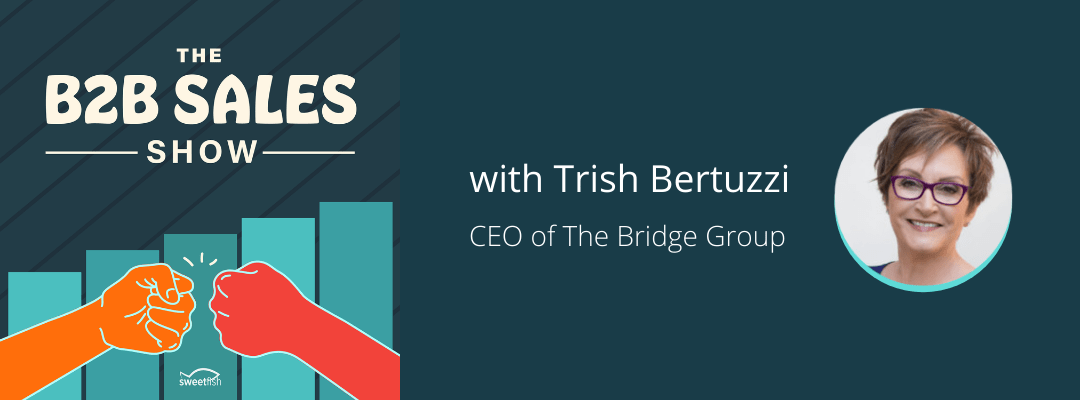Listen to the full episode:
Catch the highlights:
There’s no such thing as a one-size-fits-all go-to-market strategy. And, if anyone tells you otherwise, they’re probably just trying to sell you something.
On the other hand, creating a customized go-to-market strategy (or strategies) from scratch can seem daunting—even for the most seasoned of sales leaders.
So, what’s the best path forward for your company?
In our latest episode of The B2B Sales Show, Founder and CEO of The Bridge Group, Trish Bertuzzi, joins Mixmax’s Don Erwin to share strategic insights from her top-rated book, The Sales Development Playbook, and discuss best practices for developing iterative go-to-market strategies that deliver results.
Go-to-Market Strategy: One vs. Many
According to Trish Bertuzzi, an important—yet frequently overlooked—step in the strategic planning process should focus on identifying the right number of go-to-market strategies.
“Some business leaders assume that they only need one go-to-market strategy when, in fact, they actually need multiple strategies to achieve their revenue targets,” Bertuzzi said. “For example, you might need an ABM strategy for 20 percent of your revenue, but that other 80 percent might need to come from SMB and mid-market.”
Even when leveraging a multi-pronged approach, specific and clearly defined revenue targets must play a guiding role for allocating financial and human resources.
“Ask yourself where you want revenue to come from,” Bertuzzi said. “Keep asking yourself that until you identify a definitive answer, then put the bulk of your resources there.”
Continuous, data-driven analysis is key for ensuring each strategy achieves liftoff in a rapidly evolving business environment.
“Companies sometimes fail to reexamine their go-to-market strategies,” Bertuzzi said. “Markets change, buyers change, new competitors enter the space, new regulations come into play, which is why your strategy must be as iterative as your SDR, AE, and CSM processes.”
7 Variables that Impact Your SDR Team Composition
So, what’s the best way to structure your SDR team to ensure alignment with your go-to-market strategies?
As with the strategic planning process itself, there’s no cookie-cutter approach to building an effective SDR team. In fact, as Trish points out, there are seven key variables that must be considered prior to structuring your SDR team:
1. Brand recognition.
2. Your ICP (Ideal Customer Profile) and buyer personas.
3. The quality of your inbound funnel.
4. Average deal size.
5. Who you’re selling to within an organization. (i.e., Director of Ops, IT Manager, etc.)
6. How your solution fits into the adoption lifecycle. (i.e., innovator vs. rip-and-replace)
7. Length of your sales cycle.
Carefully considering all of these variables puts you in a better place to build an SDR team that’s optimized for your go-to-market goals.
Tactical & Messaging Tips from Trish
Carefully constructed strategic plans offer minimal value without proper tactical foresight. Case in point, engaging mid-market leads with a message that’s too vague or optimized for enterprise buyers can undermine even the best go-to-market strategy. That’s why Trish Bertuzzi recommends a top-down messaging approach that simultaneously empowers SDRs to do what they do best.
“There’s a significant difference between creating the message and using your own style to communicate the message,” Bertuzzi said. “I fall on the side of letting SDRs use their own style to communicate a corporate-derived message.”
What’s the best approach for developing a message that actually resonates with potential buyers? Once again, it all goes back to understanding the buyer’s needs in relation to your solution.
“It depends on who you’re selling to and where they’re at in the adoption lifecycle,” Bertuzzi said. “The message to a well-educated buyer in a well-understood space could be much different than that of a rip-and-replace, commoditized environment.”
Relevant wording and proper punctuation aren’t the only ingredients for an effective message. Where and when you tell your story can be just as important.
“Never tell your story in one communication,” Bertuzzi said. “Use voicemail, emails, and social to tell little chapters of your story instead of going for the whole enchilada in one communication type.”
Iterate Faster with Mixmax
Mixmax is an outbound communications management tool that’s built to help you scale all of your go-to-market initiatives. From automated sequences to rich media email templates to data-driven reports, Mixmax creates the bandwidth you need to reach more people and iterate faster.
Start your free trial of Mixmax today.




